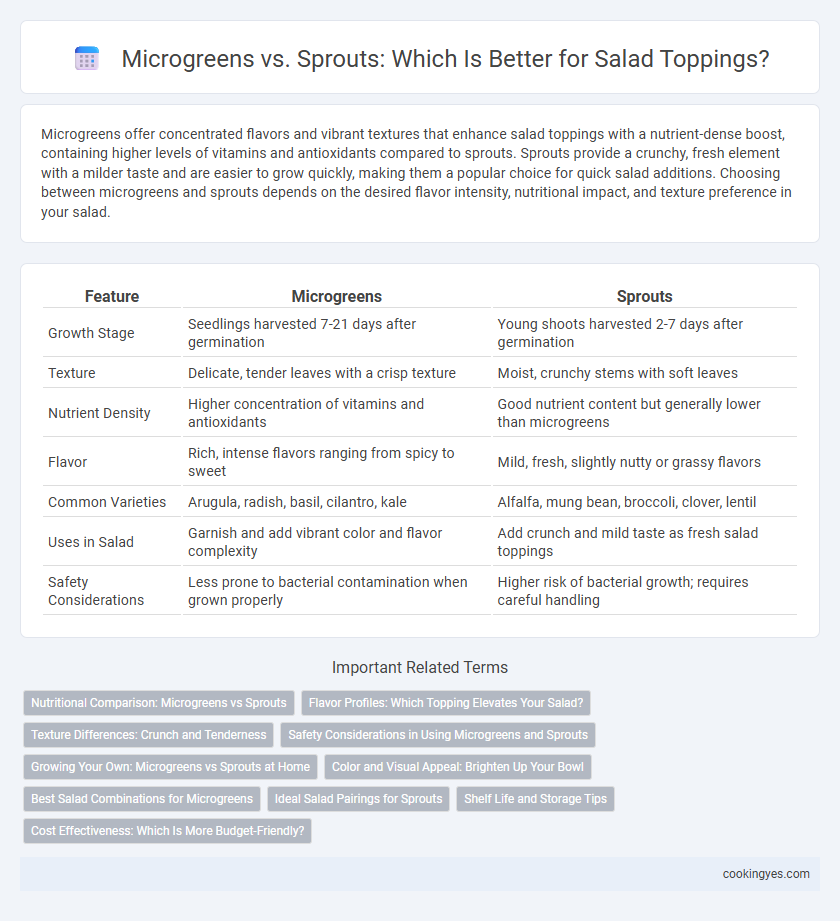Microgreens offer concentrated flavors and vibrant textures that enhance salad toppings with a nutrient-dense boost, containing higher levels of vitamins and antioxidants compared to sprouts. Sprouts provide a crunchy, fresh element with a milder taste and are easier to grow quickly, making them a popular choice for quick salad additions. Choosing between microgreens and sprouts depends on the desired flavor intensity, nutritional impact, and texture preference in your salad.
Table of Comparison
| Feature | Microgreens | Sprouts |
|---|---|---|
| Growth Stage | Seedlings harvested 7-21 days after germination | Young shoots harvested 2-7 days after germination |
| Texture | Delicate, tender leaves with a crisp texture | Moist, crunchy stems with soft leaves |
| Nutrient Density | Higher concentration of vitamins and antioxidants | Good nutrient content but generally lower than microgreens |
| Flavor | Rich, intense flavors ranging from spicy to sweet | Mild, fresh, slightly nutty or grassy flavors |
| Common Varieties | Arugula, radish, basil, cilantro, kale | Alfalfa, mung bean, broccoli, clover, lentil |
| Uses in Salad | Garnish and add vibrant color and flavor complexity | Add crunch and mild taste as fresh salad toppings |
| Safety Considerations | Less prone to bacterial contamination when grown properly | Higher risk of bacterial growth; requires careful handling |
Nutritional Comparison: Microgreens vs Sprouts
Microgreens contain higher concentrations of vitamins C, E, and K compared to sprouts, offering a nutrient-dense salad topping that enhances antioxidant intake. Sprouts, while rich in enzymes and beneficial gut-friendly bacteria, typically have lower overall vitamin content but contribute to improved digestion. Choosing microgreens over sprouts can boost the salad's nutritional profile with more potent phytonutrients and minerals like iron and magnesium.
Flavor Profiles: Which Topping Elevates Your Salad?
Microgreens offer a more intense and concentrated flavor compared to sprouts, with varieties like arugula microgreens adding a peppery kick and radish microgreens delivering a spicy zest. Sprouts, such as alfalfa or mung bean sprouts, provide a milder and fresher taste with a crisp texture that complements lighter salad greens. Choosing between microgreens and sprouts depends on whether you want a bold, robust flavor or a subtle, refreshing crunch to elevate your salad.
Texture Differences: Crunch and Tenderness
Microgreens offer a delicate crunch with tender leaves that enhance salad texture without overwhelming other ingredients. Sprouts typically provide a juicier, softer bite with a slight snap, adding freshness but less crispness than microgreens. Choosing between them depends on desired salad mouthfeel, balancing microgreens' crispness against sprouts' gentle tenderness.
Safety Considerations in Using Microgreens and Sprouts
Microgreens are generally safer than sprouts because they are grown in soil or a soil substitute, reducing exposure to the moisture that promotes bacterial growth common in sprout production. Sprouts require warm, humid conditions that increase the risk of contamination by pathogens such as Salmonella and E. coli, necessitating careful sourcing and thorough washing before use. Choosing microgreens for salad toppings minimizes safety concerns, especially when sourcing from trusted suppliers adhering to food safety standards.
Growing Your Own: Microgreens vs Sprouts at Home
Growing your own microgreens offers a faster harvest, typically within 7-14 days, compared to sprouts that mature in 2-7 days, making sprouts ideal for quick salad toppings. Microgreens provide a broader variety of flavors and nutrient density, including vitamins C, E, and K, enhancing salad nutrition. Both require minimal space and equipment, but microgreens need soil or a growing medium, whereas sprouts grow in water, influencing the choice based on convenience and desired texture for salads.
Color and Visual Appeal: Brighten Up Your Bowl
Microgreens offer a vibrant variety of colors, from deep purples to bright reds and vivid greens, enhancing the visual appeal of any salad. Sprouts typically display more muted tones, often pale greens and whites, providing subtle contrast rather than bold color accents. Choosing microgreens as salad toppings brightens up your bowl with eye-catching hues that make each bite visually enticing.
Best Salad Combinations for Microgreens
Microgreens offer a vibrant crunch and concentrated flavor that enhances salad toppings, making them ideal for diverse salad combinations like arugula with sunflower microgreens or kale paired with radish microgreens. Their dense nutrient profile provides a boost of vitamins A, C, and K, improving the overall health benefits of the salad. Selecting microgreens such as pea shoots or cilantro microgreens can create fresh, zesty layers that complement mixed greens and roasted vegetables perfectly.
Ideal Salad Pairings for Sprouts
Sprouts, such as alfalfa and mung bean, offer a delicate crunch and mild flavor that enhance fresh salad greens without overpowering them. Their high water content and tender texture make them ideal for light, crisp salads featuring ingredients like cucumber, radishes, and avocado. Combining sprouts with citrus-based dressings or light vinaigrettes preserves their freshness and adds a vibrant burst of flavor to any salad.
Shelf Life and Storage Tips
Microgreens offer a longer shelf life than sprouts, typically lasting up to a week when stored in a refrigerator at 32-40degF (0-4degC) in a sealed container with a paper towel to absorb moisture. Sprouts generally last 2-3 days and require rinsing and draining twice daily to prevent bacterial growth. Keeping both microgreens and sprouts dry and chilled optimizes freshness and reduces spoilage for salad toppings.
Cost Effectiveness: Which Is More Budget-Friendly?
Microgreens generally cost more than sprouts due to longer growing times and higher nutrient density, making sprouts a more budget-friendly option for salad toppings. Sprouts grow rapidly within 3-7 days, requiring minimal space and resources, which reduces overall expenses. Choosing sprouts can maximize salad variety and flavor without significantly increasing grocery costs.
Microgreens vs Sprouts for salad toppings Infographic

 cookingyes.com
cookingyes.com